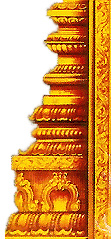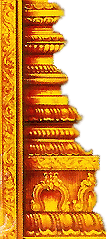|
|
Home >>
Other Temples >
sri Dakshinamurthy temple
|
| |
- Details
- Path
- Map
- Photos
- Near By Temple
| |
| Sri Dakshinamurthy temple |
|
| |
|
![[Image1]](http://img1.dinamalar.com/Kovilimages/T_500_95.jpg)
|
| | |
| | | |
|
|
|
Moolavar | : |
Dakshinamurthy |
|
|
Urchavar | : |
- | |
|
Amman / Thayar | : |
- | |
|
Thala Virutcham | : |
Banyan tree | |
|
Theertham | : |
- | |
|
Agamam / Pooja | : |
Kamikam | |
|
Old year | : |
500-1000 years old | |
|
Historical Name | : |
- | |
|
City | : |
Govindavadi | |
|
District | : |
Kanchipuram
| |
|
State | : |
Tamil Nadu |
| |
|
|
| |
|
|
 | Singers: |  |
| |
|
|
| |
- |
|
| |
|
|
 |
Festival: |
 |
| |
|
|
| |
Guru Puja in Chithirai (April-May), Jupiter transit days and Mahasivarathri Sangabishekam in Masi (February-March) are devotionally celebrated in the temple. |
|
| |
|
|
 |
Temple's Speciality: |
 |
| |
|
|
| |
The Nagadevatha appears with her two legs bent. Vinayaka is seen a special seat called Avudayar. |
|
| |
|
|
 |
Opening Time: |  |
| | | | | |
The Temple is open from 8.00 a.m. to 12.00 a.m. and 4.00 p.m. to 8.00 p.m. |
|
| | | |
 |
Address: |  |
| | | | | |
Sri Dakshinamurthy Temple, Govindavadi- 631 502, Kancheepuram dist. |
|
| | | |
 |
Phone: |  |
| | | |
| |
+91- 44 - 3720 9615, 93809 57562. | |
|
| | |
 |
General Information: |  |
| |
|
|
| |
There are shrines for Lord Kailasanathar, Mother Akhilandeswari and Lord Chandana Kunkuma Govinda. Lord Perumal graces from a separate shrine facing west. Mothers Sridevi, Bhoodevi, Aanjaneya, Garudazhwar are with Lord. As Lord Vishnu worshipped Lord Shiva here with His hymns, the place was originally called Govinda Padi and changed as Govinda Vadi later. |
|
| |
|
|
 |
Prayers |  | |
|
| | | |
People facing adverse effects of Jupiter aspects pray in the temple. | | |
|
| |  |
Thanks giving: |  | |
|
| | | |
Devotees light lamps in coconut shells. Women perform Sumangali Puja to Mother for happy wedding. | | | |
| |  |
Greatness Of Temple: |  |
| |
|
|
| |
Lord Dakshinamurthy generally has His place on the wall around the main Shiva shrine. But, this is the temple that has Lord Dakshinamurthy as presiding deity facing south. Behind is another sanctum separately for Lord Kailasanathar. Both sanctums are under a single vimana having Lord Shiva and Lord Dakshinamurthy. Lord Dakshinamurthy is the principal deity of the temple to whom Aipasi Annabishek (abishek with rice) in October-November is performed as to Lord Shiva. The other difference is that Lord Dakshinamurthy graces with an eye on the forehead and crescent moon as Lord Shiva Himself.
Lord Dakshinamurthy is seated on a peeta held by Koorma (tortoise), eight elephants, five serpents, a lion and deities of the eight directions. As He granted darshan to Lord Vishnu privately, the banyan tree is not here but a structure (mandap) representing Mount Kailash. Muyalagan the symbol of ignorance usually under the feet of Lord facing right, is facing left in this temple. Vibuti Kavadi usually attributed to Lord Shiva worship, is carried for Lord Dakshinamurthy in this temple. The sacred ash is used for abishek and given as Prasad to devotees. Devotees dissolve it in water and consume as medicine.
The symbol in the forehead of Lord Vishnu is called Namam. This is done with a sand called Tiruman. Here Kumkum and Sandal is used for this dressing-Alankara to show Vishnu was a Shiva devotee. Baghwan Adhi Sankara has a shrine in the temple remembering his visit. Serpent deities, Rahu and Ketu – also serpent planets – are in a single shrine in the prakara. Those facing adverse serpent planet effects perform milk abishek here for relief. |
|
| |
|
|
 |
Temple History: |  |
| |
|
|
| |
While on a war to protect His devotee, Lord Vishnu’s discuss slipped down and fell on Maharshi Thatheesi and lost its sharpness. Lord was discussing with Devas how to get back the discuss with its full power. He came to the conclusion that the weapon could be repaired and got back with the blessings of Lord Shiva. For Shiva worship, initiation is necessary by a learned Guru.
Lord Vishnu came here with His consorts Sridevi and Bhoodevi, had a bath in a holy spring here and began penance. Lord Shiva appeared before Vishnu, taught Shiva Mantras and initiated for the pujas. Lord Shiva also told his disciple to worship Him with 1000 flowers in the place nearby called Tirumalpur in His Linga form and assured that the discuss would come back to Him fully powered at an appropriate time. Lord Vishnu, after the Shiva worship, got back His discus. As Lord Shiva appeared before Vishnu as Guru, He is worshipped here as Lord Dakshinamurthy. |
|
| |
|
|
 |
Special Features: |  |
| |
|
|
| |
|
|
| |
|
|
|
| |
|
|
|
|
| | Location :
Govindavadi is 18 km from Kancheepuram on the Tiruthani Road. The devotee has to get down at Agaram bus stop and hire an auto. Buses from Chennai to Kancheepuram via Arakonam pass through this place.
Near By Railway Station :
Chennai
Near By Airport :
Chennai
Accomodation :
Kancheepuram:
Babu Surya: +91-44-2722 2555
Jayabala: +91-44-2722 4348
Heritage: +91-44-2723 0023
G R D: +91-44-2722 5250.
| |
|
 |
|
|
|
|
|





